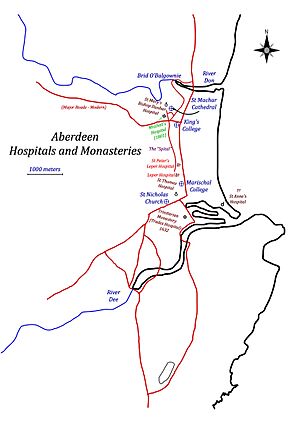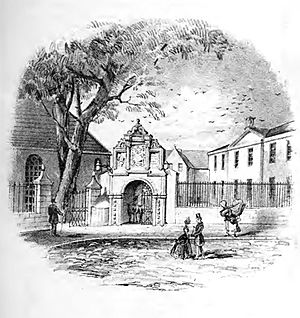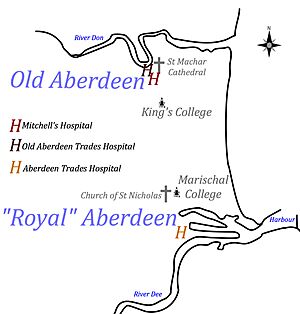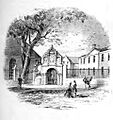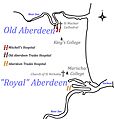Aberdeen trades hospitals facts for kids
Long ago, in Aberdeen, Scotland, people built special places called "hospitals." But these weren't always like the hospitals we know today where you go when you're sick. Many of them were more like homes or schools for people who needed help, such as the elderly, the poor, or children who needed an education.
These "hospitals" were often set up by groups of skilled workers, like bakers or shoemakers, who formed associations called "incorporated trades." These groups helped their members and their families when they faced hard times. You could find similar groups in other Scottish cities too, like Edinburgh and Glasgow. Besides these, there were also places like "workhouses" for the poor.
Contents
Early Hospitals in Aberdeen
Before the 1500s, many hospitals in Europe were built by churches. These places focused on helping people's "spiritual health" and cared for the poor, the elderly, and those with illnesses like leprosy. They weren't usually for medical treatment as we understand it now. After the 1500s, the focus shifted more towards "physical health."
Some of the church-run hospitals in Aberdeen before the 1500s included:
- Aberdeen Leper House (from around 1363)
- St Peters (from around 1179)
- St Thomas the Martyr (from 1459)
- St Mary's Old Aberdeen (from 1531)
New Hospitals After the Reformation
After a big change in the church around the 1500s (called the Reformation), new kinds of hospitals started to appear.
The Trinitarian Monastery and Hospital
A very old Trinitarian Monastery and Hospital was first built in Aberdeen around 1181. It was located near what is now Market Street. Sadly, its buildings were destroyed during the Reformation. Later, in 1632, a man named William Guild bought the land. He wanted to create a new hospital for the Incorporated Trades.
St Thomas the Martyr Hospital
The Hospital of St Thomas the Martyr was founded in 1459 by John Clatt. It was meant for the poor and sick. The people who lived there were called "Bedesmen." They were supposed to live a quiet life, focusing on prayer and good behavior. They even wore special russet gowns and badges.
However, over time, there were disagreements about who could live in this hospital. The merchants, who were often wealthier, started to take over most of the spots. In 1609, the Aberdeen Council officially decided that only merchants could be admitted, unless craftsmen started donating money to the hospital too. This decision led Dr. William Guild to create a new hospital specifically for craftsmen.
William Guild's Trades Hospital
In 1632, Dr. William Guild, a wealthy man, gave money and land to create the Trades Hospital. King Charles I approved this in 1633. Guild gave part of the old Trinity Monastery land for this new hospital and a meeting place. This hospital was for "decayed craftsmen," meaning craftsmen who were old or no longer able to work. They were also called "Beidmen."
Dr. Guild had very strict rules for the Beidmen:
- They had to attend church sermons and prayers every day.
- They had to read from the Bible and pray in their own chapel twice a day. If they missed three times, they could be removed from the hospital.
- No women were allowed to live in the hospital, not even the wives of the Beidmen.
- The Beidmen were not allowed to wander around town.
- They had to wear special gowns and live honest, peaceful lives.
- One Beidman was chosen each week to be the "janitor," responsible for opening and closing the gates and ringing a bell to call others to prayers.
The hospital had a "Master of Hospital" who managed everything, and a "Patron" (Dr. Guild was the first). There was also a "Catechist" to teach the residents about their faith.
Over time, the Beidmen found these strict rules difficult. By the late 1700s, the hospital couldn't keep going in the same way. In 1803, a court decided that the "Beidmen" could receive money to live in their own homes in the community instead of staying in the hospital. This meant the hospital was used less and less as a place to live.
The main building, Trinity Hall, continued to be the headquarters for the Incorporated Trades. However, around 1844, it had to move because of the new railway coming to Aberdeen. It moved again in 1965 to its current location.
Today, the Seven Incorporated Trades of Aberdeen still help retired craftsmen, their widows, and families by giving them money. They also do important charity and education work, especially for crafts and trades.
Lady Drum Hospital
In 1664, Lady Drum gave £2000 to start a hospital for widows of merchants and for single older women (spinsters). This hospital helped fill a need for women in Aberdeen, as there weren't many places like it after the nunneries closed.
The hospital was built off Gallowgate, in what is now Drum Lane. It was used as a refuge for women from about 1671 until 1798. The women living there received money each year to help with their needs.
Litsters Hospital
There's also some information about a hospital used by "distressed women" connected to the Litsters Guild. This guild was for dyers and was not part of the main Incorporated Trades.
The Trades Hospital in Old Aberdeen
Old Aberdeen was once a separate town from "New" Aberdeen. In 1708, the Incorporated Trades in Old Aberdeen decided to try and build a hospital for their elderly members. They started collecting money for it.
By 1711, they had a plan for a two-story building with several rooms. The different trades (like hammermen, weavers, tailors, shoemakers, and fleshers) contributed money. In 1712, the building was finished. The trades then decided which rooms each group's members would get. They even asked the head of King's College, Dr. George Middleton, to be the Patron of the Hospital.
An account from 1725 mentions that the hospital had rooms for ten poor widows of tradesmen. They received a small allowance and some charity from people in the town.
However, it seems that keeping the hospital funded was a big problem. By 1792, after some disagreements among the trades, they decided to sell the building for fifty pounds sterling. It's not clear exactly why it closed, but it might have been due to funding issues, strict rules, or perhaps more people preferred to live with their families.
Images for kids
See also
- Aberdeen charitable trusts
- Scottish Bedesmen
- Bishop Dunbar's Hospital
- Mitchell's Hospital Old Aberdeen
- Cowane's Hospital
- Kincardine O'Neil Hospital, Aberdeenshire
- Hospitals in medieval Scotland
- Aberdeen poorhouses
- Hospital chantry


